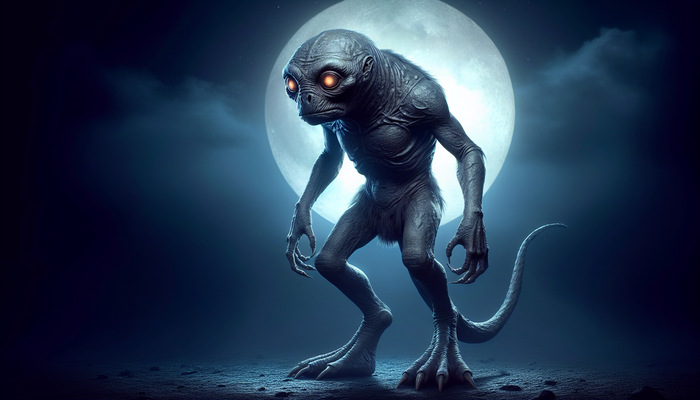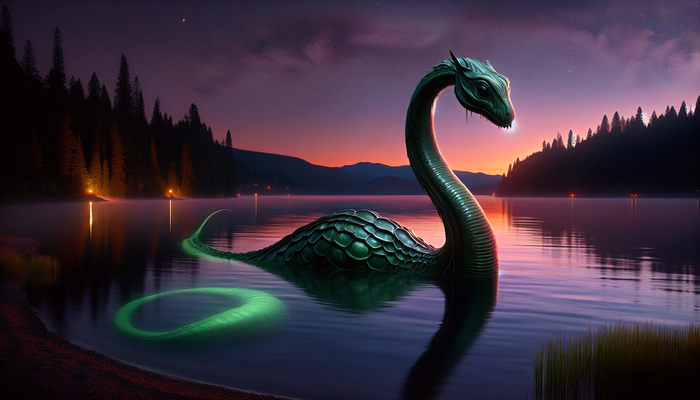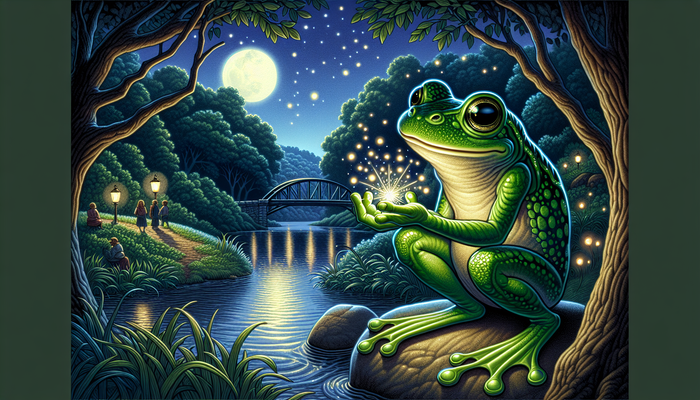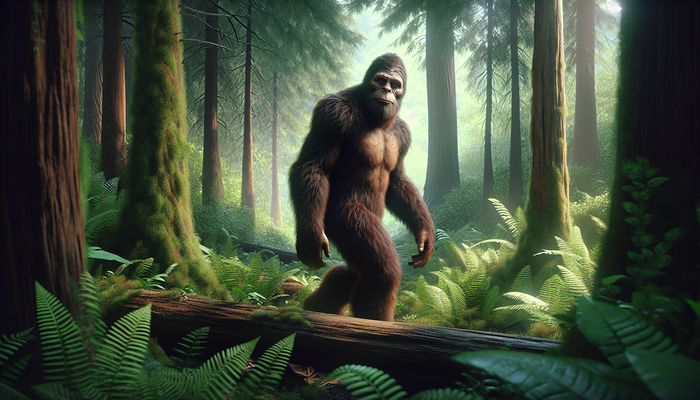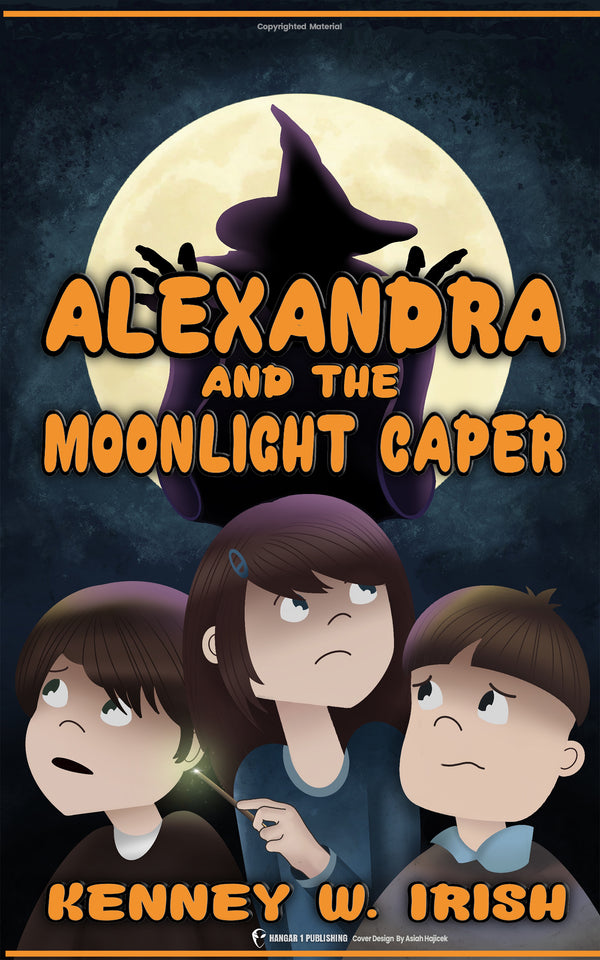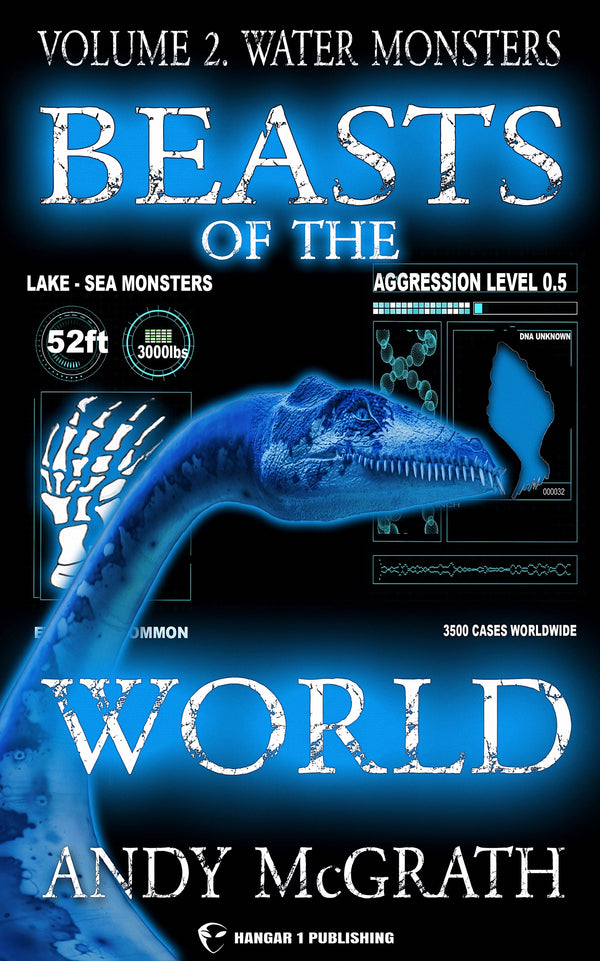Beelzebufo: The Armored Devil Frog that Devoured Dinosaurs
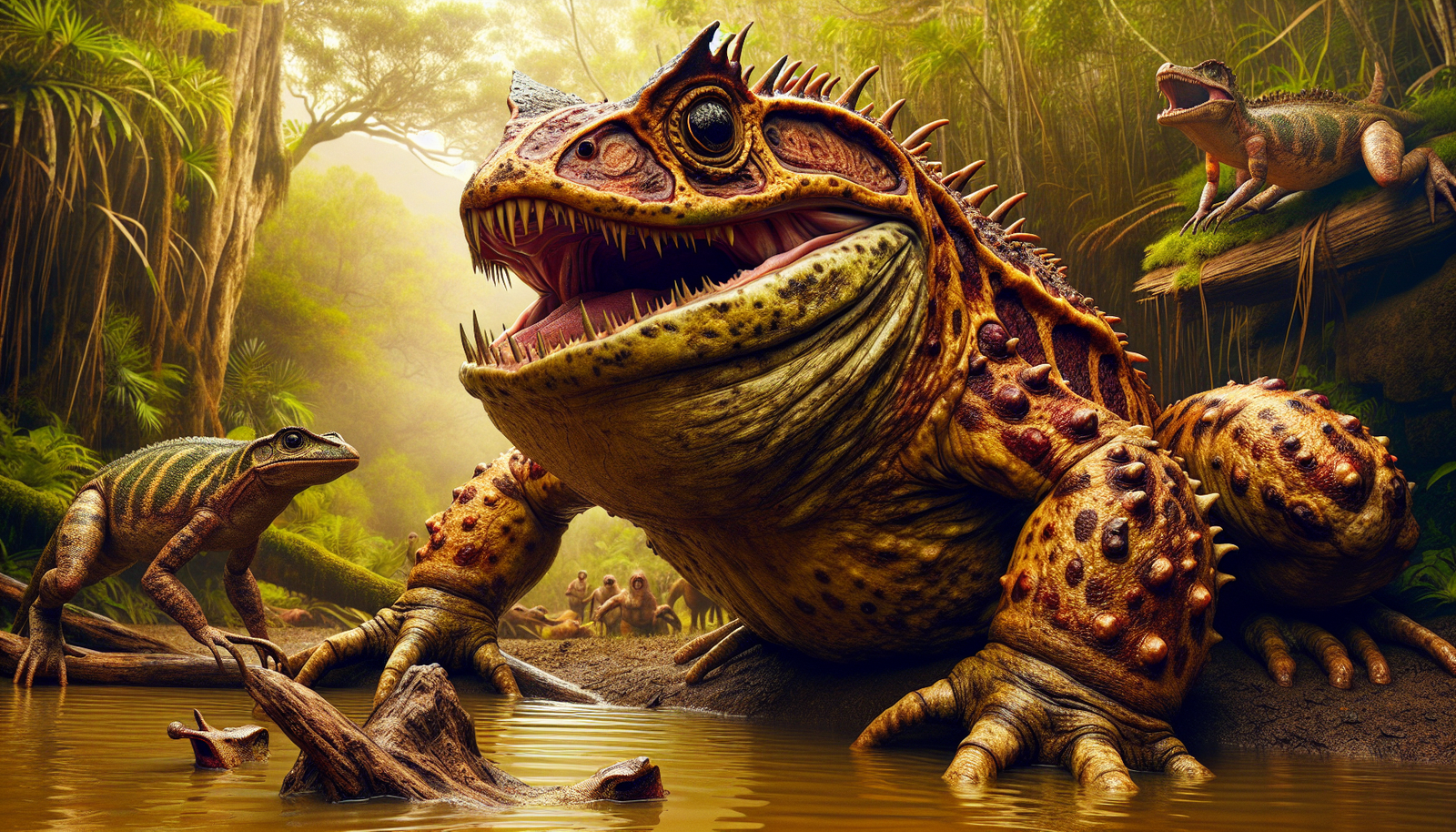
By Dr. Elizabeth Harper, Cryptozoologist and Biologist
Picture this: a frog as big as a beach ball, with a head full of armor and a mouth bristling with sharp teeth. It sounds like something out of a science fiction movie, doesn't it? But believe it or not, this creature was very real. Meet Beelzebufo ampinga, an extinct amphibian that hopped and hunted its way through the ancient landscapes of Madagascar some 70 to 65 million years ago. Dubbed the "devil frog" or "frog from hell" by the researchers who discovered it, Beelzebufo was one of the largest frogs to have ever existed, and likely a formidable predator in its time.
As a biologist and cryptozoology enthusiast, I've always been fascinated by the incredible diversity of life on our planet, both past and present. And when I first learned about Beelzebufo, I was absolutely captivated. Here was a creature that defied all expectations of what a frog could be - gigantic, armored, and with a bite powerful enough to take down small dinosaurs. I knew I had to dig deeper and learn everything I could about this astounding animal.
The Discovery of Beelzebufo
The story of Beelzebufo's discovery begins in 1993, when paleontologist David Krause and his team were exploring the fossil-rich beds of the Maevarano Formation in northwestern Madagascar. Among the many bones they unearthed were a few tantalizing fragments that seemed to belong to a large frog, but it was impossible to say much about the size or appearance of the animal based on these scraps alone.
It would take another 15 years of painstaking work, with Krause and his colleagues returning to the site again and again to collect more fossils, before they had enough material to piece together a fuller picture of this enigmatic amphibian. In total, they amassed some 75 fossil fragments, which they carefully cleaned, studied, and puzzled back together like a giant, three-dimensional jigsaw.
When they finally published their findings in 2008, the paleontological world sat up and took notice. They had not just discovered a new species of frog, but one of the largest frog specimens known to science. They gave it the scientific name Beelzebufo ampinga - a dramatic moniker befitting such an impressive beast.
The Size and Proportions of Beelzebufo
But just how big was Beelzebufo? The answer is enough to give even the bravest among us pause. The largest specimens are estimated to have been up to 16 inches long from snout to vent and may have weighed as much as 10 pounds. That's about the size of a respectable beach ball and heavier than any frog alive today. To put that in perspective, the largest living frog, the goliath frog of West Africa, maxes out at around a foot in length and 7 pounds in weight. Beelzebufo would have dwarfed even these giants.
And it wasn't just the devil frog's overall size that was impressive - its proportions were extraordinary too. Beelzebufo had a head that was absolutely massive, even relative to its already hefty body. The skull was extremely wide and flat, shaped almost like a battering ram. And then there was the mouth. Broad and cavernous, it gaped so wide that it's been described as "a mouth with legs." That mouth was lined with sharp, pointed teeth, almost like fangs, and powered by jaw muscles of exceptional strength.
The Bite Force of Beelzebufo
In fact, recent biomechanical studies suggest that Beelzebufo may have had a bite force comparable to that of a wolf or even a female tiger - up to 2200 Newtons, which is around 500 pounds of force. That's an astonishing amount of power for an amphibian. With jaws like that, Beelzebufo would have been capable of taking down some seriously large prey.
The Armor and Spikes of Beelzebufo
But the devil frog's arsenal didn't end with its size and bite. This was a frog that came heavily armored, almost like a battle tank. The skull was incredibly thick and dense, covered in bony scutes that formed a kind of protective helmet. Even more intriguing were the small, spiky flanges that protruded from the back of the skull, giving Beelzebufo a positively devilish appearance. These features are rarely seen in frogs, and their exact purpose remains something of a mystery.
Some researchers have suggested that the armor and spikes may have helped protect Beelzebufo from the jaws of the many predators it coexisted with, such as the meat-eating theropod dinosaurs and ancient crocodiles found in the same fossil beds. A heavily fortified head would certainly be an advantage when trying to avoid becoming another animal's lunch.
Others have proposed that these skull features could have been a burrowing adaptation, allowing Beelzebufo to dig into the ground and escape the intense heat and aridity that often prevailed in its semi-arid environment. Many frogs today are known to burrow to avoid desiccation, so it's not an unreasonable hypothesis.
The Diet of Beelzebufo
But of course, the most tantalizing question is what Beelzebufo itself ate. An animal this large and powerfully built must have been a formidable predator, but what exactly was on the menu for the devil frog? Here, we can look to Beelzebufo's closest living relatives for clues.
The extinct frog shares many similarities with a group of South American frogs known as the Ceratophryidae, or horned frogs. These rotund, big-headed amphibians are sometimes called Pacman frogs because of their exceptionally wide mouths, which can gape up to 180 degrees. They are ambush predators, sitting quietly camouflaged in the leaf litter until an unsuspecting victim wanders by, then springing forward with lightning speed to snatch their prey with their highly adhesive tongues.
Horned frogs are notorious for being voracious and indiscriminate eaters, consuming anything they can fit into their mouths. This includes insects, spiders, small mammals, reptiles, and even other frogs. Some large horned frog individuals have even been documented eating bats and venomous snakes. If Beelzebufo had a similar appetite, combined with its much larger size, it's not hard to imagine it chowing down on the many small vertebrates it shared its habitat with, from early mammals to reptiles and possibly even hatchling dinosaurs.
In fact, the idea of Beelzebufo as a dinosaur hunter has captured the imagination of many a paleontologist and artist. Numerous depictions show the devil frog battling or consuming baby dinosaurs, taking advantage of its powerful jaws and deadly bite. While this makes for a thrilling image, the reality is that we can't say for certain whether Beelzebufo regularly tangled with dinosaurs. But what we do know is that its bite would have been powerful enough to pose a threat even to small adult dinosaurs, let alone defenseless juveniles.
The Evolutionary Origins of Beelzebufo
Of course, no discussion of Beelzebufo would be complete without delving into the question of its evolutionary origins and relationships. And this is where things get really interesting, because the devil frog presents something of a paleobiogeographical conundrum.
As mentioned, Beelzebufo shares many morphological similarities with the living horned frogs of South America, to the point that some researchers initially classified it as a member of the same family, the Ceratophryidae. But there's a big problem with this idea: Madagascar and South America have been separated by thousands of miles of ocean for a very, very long time.
The last time these landmasses were directly connected was around 135 million years ago, when they were both part of the supercontinent Gondwana. By the time Beelzebufo was hopping around Madagascar in the Late Cretaceous, some 70 million years ago, Madagascar had long since broken away and was isolated in the Indian Ocean. So how do we explain the close resemblance between these geographically distant frogs?
One possibility is that the similarities between Beelzebufo and the horned frogs evolved independently, a case of convergent evolution. In other words, the frogs may have developed similar features because they were adapting to similar ecological niches, not because they were closely related. It's a phenomenon we see over and over again in nature - just think of the streamlined bodies of sharks, dolphins, and ichthyosaurs, or the spiny defenses of hedgehogs and porcupines.
But there's another, more intriguing hypothesis. What if the ancestors of Beelzebufo and the horned frogs were more widespread in the ancient past, perhaps occupying a range that included both South America and Madagascar when the continents were still joined? The frogs could have then evolved separately in each location after the landmasses split, retaining some ancestral similarities.
This idea, though speculative, has been bolstered by some recent fossil finds. In 2008, the same year that Beelzebufo was officially described, another team of researchers reported the discovery of a frog called Baurubatrachus from the Late Cretaceous of Brazil. Baurubatrachus shares many features with both Beelzebufo and the modern horned frogs, suggesting that this group may have had a much wider distribution and longer evolutionary history than previously thought.
But the story doesn't end there. More recent phylogenetic analyses, which use statistical methods to infer evolutionary relationships based on morphological and genetic data, have called into question the idea that Beelzebufo is closely related to the horned frogs at all. A 2018 study suggested that the devil frog may actually be part of a much older lineage of frogs, only distantly related to the Ceratophryidae. If this is true, then the similarities between these frogs may indeed be a result of convergent evolution rather than shared ancestry.
But just a few years later, a 2022 study swung the pendulum back the other way, finding evidence that Beelzebufo and Baurubatrachus form a sister group to the horned frogs, meaning they share a more recent common ancestor with each other than with other frog lineages. The debate, it seems, is far from settled.
The Extinction of Beelzebufo
Unfortunately, like so many of the magnificent creatures of the Mesozoic, Beelzebufo's reign was cut short by the catastrophic end-Cretaceous extinction event. Around 66 million years ago, a massive asteroid slammed into the Earth, triggering global wildfires, tsunamis, and a prolonged period of climate change. This cataclysm wiped out the non-avian dinosaurs and many other groups of animals and plants, reshaping the course of life on our planet.
We don't know for certain whether Beelzebufo was a direct victim of the asteroid impact, but it disappears from the fossil record after this time, along with the dinosaurs and many of the other strange and wonderful creatures that shared its world. It's a sobering reminder of the fragility of life and the power of global catastrophes to alter the course of evolution.
The Legacy of Beelzebufo
But it's also a testament to the resilience and adaptability of life. From the ashes of the Cretaceous world, new forms of life emerged and thrived, including the ancestors of modern frogs. Today, there are over 7,000 known species of frogs, found on every continent except Antarctica. They have adapted to a dizzying array of habitats and lifestyles, from the aquatic to the arboreal, the desert to the rainforest.
And while no frog today can match Beelzebufo in size or ferocity, they continue to surprise and inspire us with their diversity and their many unique adaptations. From the poison dart frogs with their toxic skin secretions to the glass frogs with their transparent bellies, from the tiny Cuban Monte Iberia Eleuth that can fit on a fingernail to the goliath frog that can weigh over 6 pounds, frogs are a constant reminder of the wonders of the natural world.
For me, learning about Beelzebufo has been a journey of discovery and amazement, a chance to peer back in time to a world so different from our own and yet so strangely familiar. It's a reminder that even the most unassuming of creatures can have a monstrous past, and that the story of life on Earth is one of constant change, adaptation, and surprise.
But it's also a reminder of how much we still have to learn. Despite the many advances in paleontology and evolutionary biology in recent years, there are still so many questions left unanswered about Beelzebufo and its world. We still don't know for certain how it's related to other frog lineages, what the full extent of its range and habitat was, or the details of its behavior and ecology.
These are the kinds of questions that drive me as a scientist and a explorer. Every fossil is a clue, a tiny window into a lost world that we can only imagine. And every new discovery has the potential to rewrite what we thought we knew, to challenge our assumptions and expand our understanding of the incredible story of life on this planet.
So while Beelzebufo may be long gone, its legacy lives on - in the fossils that bear witness to its existence, in the living frogs that carry echoes of its adaptations, and in the minds of all those who are captivated by the mysteries and wonders of the prehistoric world. For me, the devil frog will always be a symbol of the incredible power and potential of evolution, and a reminder of the many astonishing creatures that have called this Earth home.
From Bigfoot to UFOs: Hangar 1 Publishing Has You Covered!
Explore Untold Stories: Venture into the world of UFOs, cryptids, Bigfoot, and beyond. Every story is a journey into the extraordinary.
Immersive Book Technology: Experience real videos, sights, and sounds within our books. Its not just reading; its an adventure.



